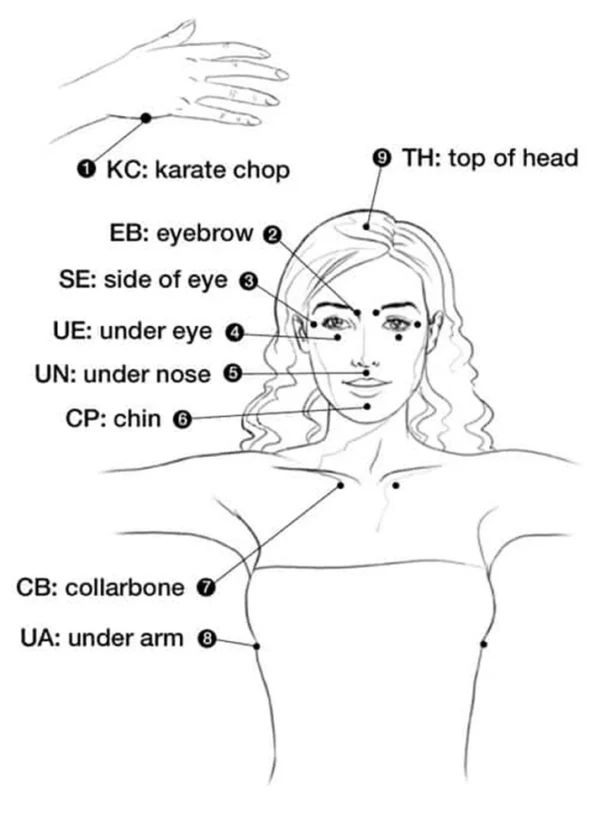“Tapping Your Way to Calm” is the first in a monthly column of mental health articles by Karen Munson. Read the next article, “Grounding Emotionally,” at the link.
In previous Byway Issues, the newspaper published a few ways we can help ourselves emotionally, mentally and physically. The first article addressed having a morning routine to lay a foundation for the rest of the day. The second article was about grounding, or earthing, by physically connecting to the earth to replace electrons we lose throughout the day and achieve more balance. This article on tapping is yet another option to achieve relief from emotional turmoil.
Emotional Freedom Therapy (EFT), or “tapping,” is a combination of ancient Chinese acupressure and modern psychology. Gary Craig founded this integration of east and west medicine in 1995.
EFT has been shown to help reduce stress and anxiety levels by helping patients focus on the present moment rather than worrying about the past or future. Like acupuncture, pressure is applied to certain points on the body using percussive taps with your fingertips.
Acupuncture usually addresses 300 pressure points, whereas tapping only utilizes nine. These points correspond with “meridians,” which are energy pathways throughout the body. Tapping at the endpoints of meridian lines while focusing on stressors sends a calming message to the amygdala, which is the part of our brain that processes fear or perceived threat. The tapping pressure rewires how the brain works.
Everyone’s body has meridians, the invisible pathways flowing back and forth to every major system. These channels can get blocked through stress, trauma, injury, anxiety, depression, pain, etc. Tapping and calming the amygdala allows these meridians to relax and open to release the blockage.
Stress reduction can be measured by lowered cortisol levels in the body. Cortisol, often referred to as the ‘stress hormone,’ is released into the bloodstream by your adrenal glands in response to stress. Cortisol triggers our fight-or-flight response to danger. It can save us at healthy levels. It can kill us at unhealthy levels.
The US Veterans Administration now approves EFT to treat PTSD, depression, anxiety, and pain. In one study, military veterans were given six EFT treatments of 16 minutes each. Their mouths were swiped to measure cortisol before and after the treatments.
At the end of the sessions, the level of cortisol had drastically reduced in these men who had all been diagnosed with PTSD. Follow-up studies showed that after 3, 6, 9, and 12 months, the results had persisted. They no longer had the symptoms that led to the PTSD diagnosis.
And it isn’t just for veterans. Tony Robbins, international author, coach and speaker, said that “Tapping is a breakthrough, research-backed technique that I’ve used in my life and seen people around the world get incredible results with.”
People of all ages can benefit from EFT. High school students with test anxiety saw a lasting, significant decrease after tapping.
You don’t need a professional practitioner to administer the tapping. You can do it yourself by following the steps below.
Simplified Tapping Steps
Before you do anything, identify an emotional or physical pain. What is bothering you the most right now?
1. Assign that pain a number 1-10 based on its severity.
2. Set up the tapping process with the statement, “Even though _________________, I deeply and completely love and accept myself.”
For example: “Even though I am livid about what happened last night, I deeply and completely accept myself.” Using one or two fingers, tap the opposite hand while you say this phrase, identifying your emotional or physical pain.
Tap 5-7 times on each of the remaining eight pressure points as you continue to speak your statement about the pain, honestly expressing how you feel about it.
For example: “All the humiliation of being laughed at. All the pain, all the shame. All the embarrassment.” After the first round, identify what number reflects the current level of pain.
3. Start a second round by using positives about the pain, such as how it is not affecting you as much, how you’ve learned a lot through the process, how you are shifting your perception about it, how it is being released to the past and no longer in the present, etc.
For example: “I was embarrassed, but not now. I know those things are not true about me. I am a strong person. This is running off my back like water on a duck. I have changed from the person they thought they knew. I am at peace with who I am now. I can continue on my journey of healing without fear. I am strong and resilient. I have nothing to prove. I will continue to be true to my path.” Of course, use your own narrative of healing thoughts, variations of what your originally-stated pain was.
4. Continue with this process until the pain number is below three.
You may not feel immediate results. Keep at it a few times and check in with yourself.
Brain scans confirm 76% of patients treated with EFT experienced complete remission. Tapping releases stress. Most people do not even realize how stressed they are, holding tightly onto schedules, daily expectations and toxic relationships. These all build tension in our bodies.
Our bodies are our friends, whispering at first when pain is introduced through an event or perceived threat. The message gets louder, but we often block it out with our busyness, which keeps us distracted and out of tune with the pain.
By slowing down and listening to our bodies, we can discover and address what needs attention. Tapping is free, easy, simple, fast, and effective. It does not require drugs or surgery and has no unwanted side effects. The founder, Gary Craig, refers to EFT as the unseen therapist. You are in absolute control. If you want to watch a video of how to do this, check out The Tapping Solution Documentary Film.
– by Karen Munson
Feature image courtesy of TheTappingSolution.
Read more about the symptoms of anxiety, depression and PTSD in another recent series on Mental Health Awareness.
Read the next article on Grounding Emotionally here.

Karen M. Munson – Escalante
Karen is an associate editor at The Byway. She is fascinated and fulfilled by all things involved with writing. After graduating from BYU, she taught English at Escalante High School for three years. She pursues opportunities to write and support others in their writing. Karen has published three books with four more scheduled to be released in 2024. She and Reed are the parents of ten children and the grandparents of 35 grandchildren.
Karen is the author of the New Twist on Mental Health column in The Byway.

